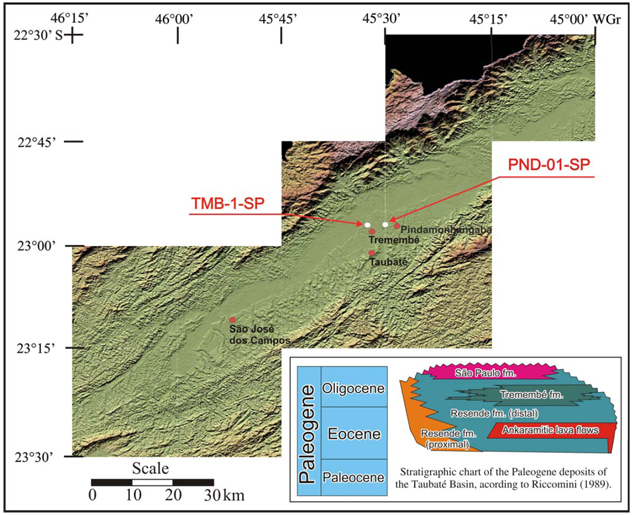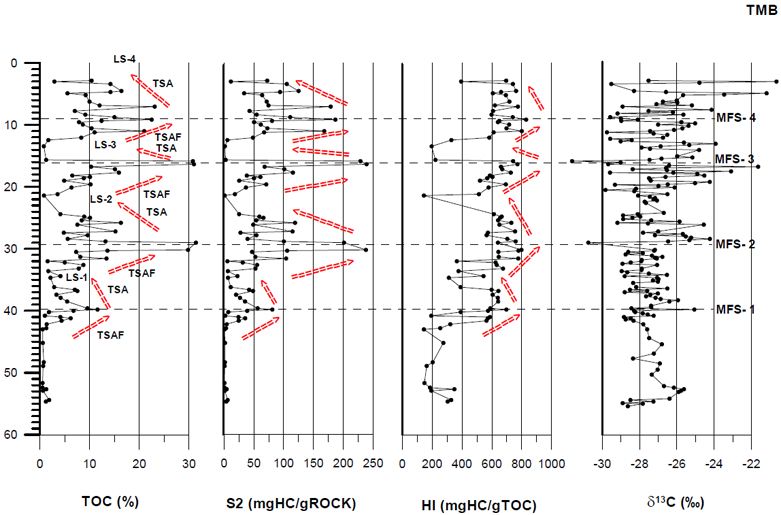 Click to view article in PDF format.
Click to view article in PDF format.
Oil Shale from the Tremembé Formation, Taubaté Basin, Brazil*
Sergio Bergamaschi1, René Rodrigues1, and Egberto Pereira1
Search and Discovery Article #80080 (2010)
Posted February 8, 2010
*Adapted from extended abstract prepared for oral presentation at AAPG International Conference and Exhibition, Rio de Janeiro, Brazil, November 15-18, 2009.
1 Faculty of Geology, Rio de Janeiro State University, Rio de Janeiro, Brazil ([email protected])
Several Brazilian basins contain deposits of pyrobituminous shales, which have been investigated in the last decades for their economic exploration for industrial extraction. Such deposits are related to the Irati Formation (Permian of the Paraná Basin), Codó Formation (Aptian of the Parnaíba and São Luiz basins) and Tremembé Formation (Oligocene of the Taubaté Basin).
We discuss in more detail the oil shale of the Tremembé Formation, in light of new geochemical data obtained from boreholes drilled in the depocenter of Taubaté Basin. The focus of this research was the interval (ca. 50 m thick) of higher concentration of organic matter of the drilled unit. TOC, total S, major, minor and trace elements, and Rock-Eval pyrolysis analyses were carried out. Based on these data, a high-resolution chemostratigraphic analysis was performed, making possible the recognition of ten chemostratigraphic units, which were correlated in the two studied wells. In addition, the application of chemostratigraphy to sequence stratigraphic analysis also proved to be a very effective tool (four 5th order sequences were identified). Based on TOC and Rock-Eval data, two intervals were selected for economic exploitation and industrial processing.
|
|
Resources from bituminous oil shales occur in numerous countries, among which about 33 have relevant deposits from the economic point of view. Among these, three countries (U.S., Russia and Brazil) account for approximately 86% of the resources, in terms of the content of bituminous oil shales (Brentow, 2003). In Brazil, these resources are associated with distinct sedimentary basins, in the following stratigraphic units: Irati Formation (Permian, Paraná Basin); Tremembé Formation (Oligocene, Taubaté Basin); Codó Formation (Aptian, Parnaíba Basin); Santa Brígida Formation (Permian, Recôncavo Basin); layers of bituminous oil shales of Maraú (Cretaceous, Camamu Basin); Barreirinhas Formation (Devonian, Amazonas Basin); Santana Formation (Cretaceous, Araripe Basin). Of these, two deposits have received the most interest: (1) the lacustrine oil shale of Tremembé Formation; and (2) the oil shale of the Permian Iratí Formation, a widespread unit in the southern part of the country. Currently, the industrial exploitation of these important energy sources in Brazil is restricted to the industrial plant SIX/Petrobras, in São Mateus do Sul, PR, where the extraction of hydrocarbons from the Irati Formation is carried out through rock pyrolysis. Petrobras produces shale oil at SIX, where the ore is mined from an open pit. A historical example concerning the research on the evaluation of resources refers to studies conducted by the former CNP (National Oil Council) in the 1940’s and the 1950’s. In these studies, the CNP studied and developed a pilot project to extract oil from bituminous oil shales of the Tremembé Formation in the municipality of Pindamonhangaba, São Paulo State. However, this pilot plant was shut down in the early 50’s, due to technological and economical aspects. The Taubaté Sedimentary Basin is part of an important northeast-trending system of Cenozoic taphrogenic basins, subparallel to the main structural elements of the southeastern region of the South American Platform. The origin of these depressions is related to the evolution of the Brazilian continental margin (Riccomini, 1989; Zalan and Oliveira, 2005). The Taubaté Basin separates the Serra da Mantiqueira and Serra do Mar. Its subsurface structure is known from seismic profiles (Marques, 1990) and magnetotelluric, gravity and geothermal flux data (Padilha et al., 1991). The sedimentary infill reaches a thickness of 850m. According to Riccomini (1989), the basin has been filled by alluvial deposits interlaced with lacustrine deposits, as a consequence of changing tectonic and sedimentation rates influenced by climatic oscillations from the Paleogene to the Quaternary. Objective, Materials, and Methods We discuss in more detail the oil shale deposits contained in the Tremembé Formation, a pelitic unit up to 500m thick of lacustrine origin, Oligocene in age. The focus of the research was the interval (ca. 50 m thick) of higher concentration of organic matter of the Tremembé Formation. In order to contribute to the evaluation of the potential generator of bituminous shale interval of the Tremembé Formation, two shallow drillings were conducted along the depocenter of the basin, and distant about 4 km from each other. The location of the two wells discussed in this study (TMB-01-SP and PND-01-SP, respectively in Tremembé and Pindamonhangaba regions, São Paulo State) is shown in Figure 1. In the TMB and PND wells, 48 and 46 meters respectively of shales of Tremembé Formation were recovered. From the cores of these wells 335 samples of shale were collected, at an average distance of about 20 cm. From the samples the following analyses were carried out: determination of Total Organic Carbon (TOC) and Sulfur (S) contents; major, minor and trace element contents; Rock-Eval pyrolysis, and C isotopes analysis of organic matter. The investigated deposits of Tremembé Formation consist primarily of: (a) gray to black laminated clay shale, (b) papyraceous bituminous shale, black in color, (c) green smectite clays, massive beds; and (d) sandy mudstones, greenish. In the section studied, there is a predominance of dark gray to black shale, usually showing high levels of organic matter. In general, these dark shales are laminated, with some papyraceous aspect in some thin intervals. These facies are the most characteristic record of the Tremembé paleolake (qv Riccomini, 1989, Torres-Ribeiro and Borghi, 2004). It should be noted that some intervals are characterized by the presence of layers of green smectite clays, which are exploited economically in the region. In the lower portion of TMB well there is an interval of sandy mudstone. The latter facies records the action of gravity flows in subaqueous lacustrine depositional context (Freitas, 2007). Based on these data, a high-resolution chemostratigraphic analysis was performed, which made possible recognition of ten chemostratigraphic units, which were correlated in the two studied wells. The chemical elements analysis, in addition to TOC data, shows a very good correlation to the definition of chemostratigraphic units in a high resolution approach (Figures 2 and 3). In addition, the application of chemostratigraphy to sequence stratigraphic analysis also proved to be a very effective tool (four 5th order sequences were identified). There is an excellent correlation between the TOC data and hydrocarbon generation potential (S2), showing that for the intervals with TOC > 2.0%, organic matter contained in the shales already has an excellent potential for generating hydrocarbons (S2 values > 10 mg HC/g rock) (Figure 4a). The ratio of TOC and hydrogen index (HI) also indicates that, for the intervals with TOC > 2.0%, the generation potential would be for oil and gas (HI values > 300 mg HC/g TOC). For TOC contents < 2.0%, the values of IH are less than 300 mg HC/g rock, and therefore the generation potential would be mainly for gas and condensate (Figure 4b). The integration of geochemical data permitted the subdivision of the interval in four T-R cycles (sequences) (Figure 5). The application of organic geochemical data to sequence stratigraphy had its beginning in the 1990's (Rodrigues, 2005). The principles adopted in the interpretation of the lake system of the Tremembé Formation are based on TOC and HI values, and follow those criteria adopted by Rodrigues et al. (2005). Considering that this section consists mainly of Oligocene shale with a thickness of about 50 meters, it is suggested that the four sequences defined would be of 5th order (Figure 5). Chemical stratigraphy has proved to be a very valuable tool for the establishment of high-resolution stratigraphy in the Tremembé Formation of the Taubaté Basin. Its use allowed the characterization of ten chemostratigraphic units, which were easily correlated in the two shallow wells analyzed. Application of geochemical data in the interpretation of sedimentary environments allowed the differentiation of intervals deposited in different levels of oxidation-reduction. The most important levels for economic exploitation of these deposits through industrial processing were also identified. The correlation of data obtained for the two wells contributed to the characterization of the potential for economic exploitation of the oil contained in the bituminous shales of the Tremembé Formation. Metric cycles were also recognized, representing sedimentological and geochemical variations of major importance for paleoenvironmental interpretation of the unit. Considering that the analyzed interval presents a low degree of thermal evolution, it would only be possible to exploit the high potential for generating oil and gas through industrial processing, as is performed by Petrobras in the bituminous intervals from the Irati Formation (Permian of Paraná Basin) in São Mateus do Sul (Paraná State). Based on organic geochemistry data, the most attractive intervals for industrial exploitation of oil shale are the chemostratigraphic units C (average values of the potential generation of oil = 93.6 mg HC/g rock), E (average values of the potential generation of oil = 94.08 mg HC/g rock), and G (average values of the potential generation of oil = 84.51 mg HC/g rock); especially the layers of papyraceous shale in chemostratigraphic units C and E (Figure 2). The highest average contents of TOC in the TMB-01-SP area (Tremembé) suggest that this area is more attractive for industrial exploitation of oil shale than the area of the PND-01-SP (Pindamonhangaba). Brendow, K., 2003, Global oil shale issues and perspectives, Synthesis of the symposium on Oil Shale held in Tallin (Estonia) on 18 and 19 November, 2002, Oil Shale 20 (1), p. 81-92. Freitas, M.S., 2007, Estratigrafia de Alta Resolução e Geoquímica Orgânica da Formação Tremembé, Terciário da Bacia de Taubaté, Região de Taubaté –Tremembé – SP, Rio de Janeiro State University, Faculty of Geology, Rio de Janeiro, Master Dissertation, 80 p. Marques, A., 1990, Evolução tectono-sedimentar e perspectivas exploratórias da Bacia de Taubaté, SP, Brasil. Boletim de Geociências da Petrobras, 4 (3), p. 253-262. Padilha, A.L., N.B. Trivedi, I. Vitorello, and J.M. Costa, 1991, Geophysical constraints on tectonic models of the Taubaté Basin, southeastern Brazil Tectonophysics 196, p. 157-172. Riccomini, C., 1989, O Rift Continental do Sudeste do Brasil, Geoscience Institute, University of São Paulo, São Paulo, PhD Thesis, 256 p. Rodrigues, R., 2005, Chemostratigraphy, in E.A.M. Koutsoukos (ed.), Applied Stratigraphy, Springer, Chap. 8, p. 165-178. Rodrigues, R., E. Pereira, and S. Bergamaschi, 2005, Organic geochemical characterization of Frasnian petroleum source rocks of Brazilian Paleozoic Basins, in Gondwana 12, Geological and Biological Heritage of Gondwana (R.J. Pankhurst and G.D. Veiga, eds.), Mendoza, Argentina, Abstract p. 314. Torres-Ribeiro, M., and L. Borghi, 2007, O uso de microfácies sedimentares na caracterização de potenciais rochas geradoras de um sistema lacustre paleogênico na Bacia de Taubaté, Proceedings of 4° PDPETRO - Congresso Brasileiro de P&D em Petroleo e Gas, ABPG, Campinas, Brazil. Zalán, P.V., and J.A.B. Oliveira, 2005, Origem e Evolução Estrutural dos Riftes Cenozóicos do Sudeste do Brasil, Boletim de Geociências da Petrobras 13 (2), p. 269-300.
Copyright © AAPG. Serial rights given by author. For all other rights contact author directly. |





